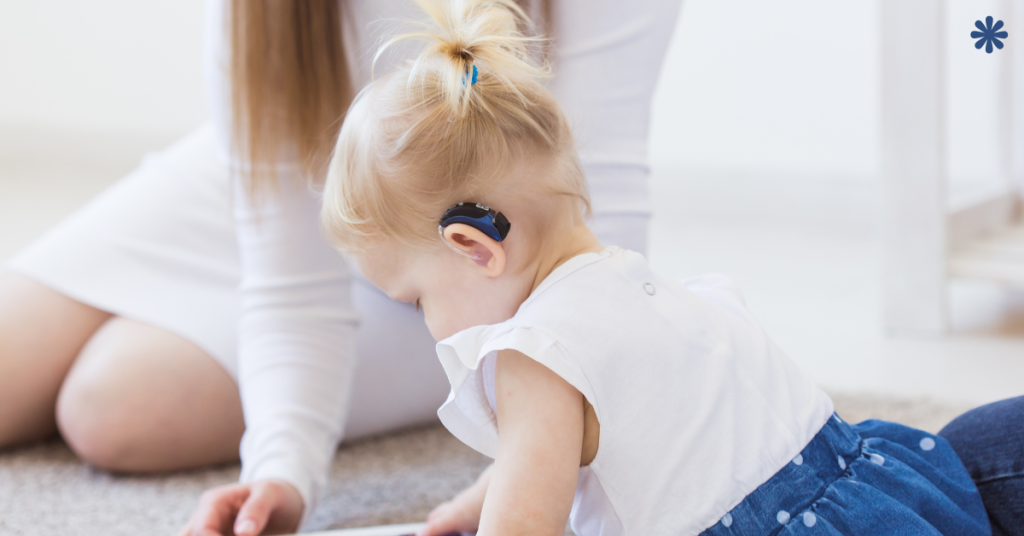Hearing is one of the most critical senses for language development. From the moment a baby is born, they are surrounded by sounds—voices, music, environmental noises—and their brain begins to interpret and make sense of these auditory signals. This early exposure to sound is the foundation upon which language is built. Without the ability to hear, or with reduced hearing ability, the pathway to understanding and producing language can be significantly altered.
Language is more than just words; it’s a complex system that involves understanding sounds (phonology), meaning (semantics), grammar (syntax), and social use (pragmatics). For children, especially in the earliest years of life, hearing provides the primary input needed to develop these skills naturally. Babies learn to speak by listening to the people around them—imitating sounds, mimicking words, and gradually forming sentences. If hearing is impaired, the brain receives less accurate or limited auditory input, which can delay or disrupt this process.
In this article, we’ll explore how hearing shapes language development throughout childhood, the risks posed by untreated hearing loss, and the importance of early identification and support. Whether you’re a parent, grandparent, educator, or caregiver, understanding the link between hearing and language is essential for nurturing strong communication skills and ensuring every child has the best start in life.
Why Hearing is Essential for Language Acquisition
Hearing plays a foundational role in how humans acquire language. From birth—and even in the womb—infants are exposed to a rich tapestry of sounds that become the building blocks of their future language. These early listening experiences are crucial for developing the ability to recognize speech patterns, understand words, and eventually form sentences. Without consistent and clear auditory input, the brain struggles to map sounds to meaning, a process that is vital for effective communication.
In the earliest months of life, babies begin to differentiate between sounds, tuning in to the rhythms and intonations of speech. This is known as phonemic awareness—the ability to hear, identify, and manipulate the individual sounds (phonemes) in spoken language. This skill is essential for developing vocabulary and learning to read. When a child hears words repeatedly in context, they start to associate sounds with objects, actions, and emotions, which is how language understanding begins.
Hearing loss, even mild or temporary, can significantly disrupt this process. Children with untreated hearing issues may miss out on subtle speech cues, making it harder to grasp new words or understand sentence structure. For example, consonant sounds like “s,” “f,” or “th” are high-frequency and easily masked by background noise or lost in cases of high-frequency hearing loss—yet they are vital for clarity in speech.
In environments rich with spoken language—like conversations, storytelling, and singing—children develop not only vocabulary but also the rhythm and melody of language. These aspects are deeply auditory and cannot be fully accessed without functional hearing. Even passive listening, such as hearing adults talk nearby, contributes to this learning process. For children with hearing loss, the lack of exposure to these natural interactions can create gaps in language development.
This is why early detection and consistent auditory stimulation are so important. When hearing is supported—through hearing aids, cochlear implants, or other interventions—children can access the sounds they need to thrive linguistically. It’s not just about being able to hear sounds; it’s about having the chance to understand them, learn from them, and use them to communicate with the world.
The Stages of Language Development and the Role of Hearing
Language development unfolds in a series of predictable stages, each heavily reliant on a child’s ability to hear and process sound. From the earliest coos to complex conversations, hearing serves as the foundation for understanding and producing speech. Any disruption in auditory input—especially during these critical developmental windows—can significantly impact a child’s language growth.
Babbling and Early Sounds (0–12 months)
During the first year, infants begin to experiment with vocalizations, starting with cooing and moving to babbling. These sounds aren’t just cute—they’re a form of early speech practice. Infants mimic the sounds they hear from parents and caregivers. A baby who isn’t hearing speech clearly or consistently may babble less or fail to progress to more speech-like sounds. This stage sets the groundwork for future speech patterns, so any hearing impairment can delay expressive language development.
First Words and Word Combinations (12–24 months)
By around their first birthday, most children say their first meaningful words. Between 18 and 24 months, vocabulary often expands rapidly—a phenomenon known as the “vocabulary explosion.” Hearing is essential during this stage because children learn words by listening and associating them with meaning. Children with hearing loss may struggle to build vocabulary at the same pace as their hearing peers, which can also delay sentence formation and grammar use.
Grammar and Complex Sentences (2–5 years)
As children grow, they begin to understand and use more complex grammatical structures. This includes proper sentence formation, use of plurals, verb tenses, and conjunctions. These language rules are not explicitly taught—they are absorbed through everyday conversation. Children with limited hearing access may miss out on these linguistic cues, leading to grammatical errors and difficulties with expressive language.
Refining Communication Skills (5+ years)
School-age children continue refining their language skills through reading, storytelling, and peer interactions. They learn how to use language for different purposes—persuading, joking, explaining, and asking questions. Hearing plays a role in developing these higher-order communication abilities. Children with hearing challenges may also struggle with reading comprehension and academic language if their foundational language skills are underdeveloped.
In each stage, hearing acts as the input channel for language learning. When hearing is impaired—either due to permanent loss or temporary issues like ear infections—the brain receives incomplete information. This can lead to gaps in both receptive language (understanding) and expressive language (speaking). The earlier the hearing issue is addressed, the better the outcome, as the brain is most adaptable and responsive to intervention in the early years.
Hearing Loss and Its Impact on Language Skills
Hearing loss can significantly affect a child’s ability to develop and use language effectively. Whether the hearing loss is mild, moderate, severe, or profound—and whether it is temporary or permanent—the impact on language skills can be far-reaching. The earlier the loss occurs and the longer it goes undetected or unsupported, the more profound the potential effects on both spoken language and academic performance.
Types and Degrees of Hearing Loss
Hearing loss can be classified into several categories: conductive (related to issues in the outer or middle ear), sensorineural (inner ear or auditory nerve damage), or mixed (a combination of both). It can also range in severity, from mild to profound. Even a mild or high-frequency hearing loss can interfere with a child’s ability to hear soft speech sounds like “s,” “sh,” or “th,” which are crucial for understanding meaning and forming clear speech.
Impact on Receptive Language
Receptive language is the ability to understand what others are saying. Children with hearing loss may have trouble following directions, understanding new words, or grasping the context of a conversation. When auditory information is incomplete or unclear, the brain has to work harder to fill in the gaps, often resulting in misunderstandings or limited comprehension. This can hinder social interactions and learning in school, especially as language becomes more complex.
Impact on Expressive Language
Expressive language refers to a child’s ability to express themselves through words, phrases, and sentences. Hearing loss can lead to delayed speech, poor grammar, reduced vocabulary, and difficulties with articulation. For instance, if a child can’t hear the difference between similar-sounding words, they may use the wrong word or mispronounce it. Over time, this can lead to frustration, reduced confidence, and reluctance to participate in conversations or classroom discussions.
Academic and Social Consequences
Language is the foundation of learning, so children with hearing loss often face academic challenges. Reading and writing skills are closely linked to oral language development, and deficits in vocabulary or grammar can make it harder to master these literacy skills. Socially, children with untreated hearing loss may struggle to form peer relationships, keep up with conversations, or interpret tone and emotion in speech, which can lead to isolation or behavioral issues.
Long-Term Language Outcomes
If hearing loss is not identified and managed early, the language gaps can widen over time. Older children and adults who experienced early hearing loss may continue to struggle with advanced vocabulary, figurative language, and abstract concepts. The good news is that with early intervention—through hearing aids, cochlear implants, and speech-language therapy—many of these effects can be minimized, helping children reach their full communicative potential.
Early Detection and Intervention: Why Timing is Everything
When it comes to hearing loss and language development, timing is critical. The first few years of a child’s life are a period of rapid brain development, particularly for areas involved in language and communication. If hearing loss is detected and addressed during this crucial window, children have a much better chance of developing age-appropriate language skills. Conversely, delays in diagnosis and intervention can lead to long-term communication and learning difficulties.
The Importance of Newborn Hearing Screening
Most developed countries now include universal newborn hearing screening as part of routine postnatal care. This quick, non-invasive test typically occurs before a baby leaves the hospital and can detect even mild degrees of hearing loss. Early screening allows families to begin the journey of diagnosis and intervention within the first few months of life—a critical advantage, as language learning begins from day one.
Critical Language Development Periods
The brain is most receptive to auditory and linguistic input between birth and age three. During this time, neural pathways responsible for processing sound and language are being formed and strengthened through exposure. If a child is not hearing adequately during this window, the brain may rewire itself away from processing spoken language, making later intervention more challenging and less effective. That’s why early action is not just helpful—it’s essential.
Intervention Options: Hearing Aids and Cochlear Implants
Once hearing loss is identified, appropriate technology can be introduced based on the child’s needs. Hearing aids amplify sound and are suitable for many types of hearing loss. For children with severe to profound loss who receive limited benefit from hearing aids, cochlear implants may be recommended. These devices bypass damaged parts of the ear and directly stimulate the auditory nerve, allowing children to access sound and begin developing spoken language.
The Role of Speech and Language Therapy
Technology alone isn’t enough—children with hearing loss often benefit from speech-language therapy, which helps them develop the skills needed to use language effectively. Therapists can assist with articulation, vocabulary building, sentence structure, and auditory training. The earlier therapy begins, the more closely a child can track with typical developmental milestones.
Parental Involvement and Consistency
Parents and caregivers play a vital role in the success of any intervention. Consistent use of hearing devices, regular therapy appointments, and a rich language environment at home all contribute to positive outcomes. Even simple activities—like reading aloud, singing, and engaging in daily conversations—can significantly enhance a child’s language development.
Early intervention offers the best chance for children with hearing loss to develop strong communication skills, succeed in school, and connect meaningfully with others. It’s a powerful reminder that hearing is not just a sensory experience—it’s a gateway to language, learning, and life.
Supporting Language Development in Children with Hearing Loss
Helping children with hearing loss develop strong language skills requires a multifaceted approach—one that includes the right technology, therapeutic support, and, most importantly, a nurturing communication environment. While hearing loss presents unique challenges, many children can achieve age-appropriate speech and language abilities with the right interventions and strategies in place.
Creating a Language-Rich Environment
One of the most effective ways to support a child’s language development is by immersing them in a language-rich environment. This means consistently talking with the child, even during routine tasks like dressing, eating, or walking. Describe what you’re doing, name objects, ask questions, and encourage responses—even if they’re nonverbal at first. Narration and repetition help reinforce vocabulary and comprehension.
Maximizing Use of Hearing Technology
Whether a child uses hearing aids or cochlear implants, consistent use is key to successful language development. Devices should be worn during all waking hours to ensure the brain receives the full range of auditory input. Caregivers should also monitor devices regularly for battery life and functionality, and work closely with audiologists to ensure optimal settings.
Utilizing Visual and Tactile Cues
Children with hearing loss often benefit from visual supports that reinforce spoken language. Gestures, facial expressions, picture books, and visual schedules can aid understanding and retention. Sign language may also be introduced, either as a primary or supplementary mode of communication, especially in early development. Tactile cues, like touching the throat to feel sound vibrations, can also be helpful in speech practice.
Working with Professionals
Speech-language pathologists (SLPs) are essential team members in supporting language development. They tailor therapy plans to the child’s specific needs, focusing on areas such as sound production, vocabulary, sentence structure, and auditory processing. Teachers of the deaf and early intervention specialists can also provide strategies and support for both children and families.
Parental Engagement and Education
Parents are a child’s first and most important teachers. Educating families about hearing loss and language development empowers them to play an active role in their child’s progress. Support groups, workshops, and online communities can offer encouragement, share strategies, and provide access to valuable resources.
Encouraging Peer Interaction
Social interactions play a huge role in language learning. Encourage playdates, group activities, and participation in preschool or daycare settings where children can practice using language with peers. Structured environments that are sensitive to hearing needs—such as reduced background noise and visual cues—can enhance communication success.
Supporting a child with hearing loss isn’t about achieving perfect speech; it’s about giving them the tools and confidence to communicate effectively in their own way. With early support and continued encouragement, children with hearing challenges can thrive—linguistically, socially, and emotionally.
Conclusion
The ability to hear is deeply intertwined with the ability to develop language. From a baby’s first babble to a child’s first sentence, hearing provides the essential input that fuels communication, learning, and social connection. When hearing is disrupted—whether due to congenital conditions, illness, or injury—the effects on language can be significant, especially if the issue goes unrecognized or unsupported.
However, hearing loss does not mean a child cannot learn to speak, listen, and thrive. With modern screening programs, early intervention, and access to hearing technologies, children today have greater opportunities than ever before to develop strong language skills, even in the presence of hearing challenges. Speech-language therapy, consistent parental involvement, and inclusive educational settings all play crucial roles in helping these children reach their full potential.
It’s important for caregivers, educators, and healthcare providers to remain vigilant about the signs of hearing loss and to act quickly when concerns arise. The sooner a child receives the support they need, the better their chances of achieving success—not just in language, but in life.
Hearing shapes language, and language shapes how we connect with others. By prioritizing early hearing health and communication development, we give every child the chance to be heard, understood, and truly connected to the world around them.
FAQ
What age should a child’s hearing be tested?
Most babies have their hearing screened before leaving the hospital. If not, it’s recommended to test hearing by one month of age. Ongoing hearing checks should occur during well-child visits, especially if there are speech or language delays, frequent ear infections, or a family history of hearing loss.
Can children with hearing loss learn to speak?
Yes, many children with hearing loss can learn to speak with the right support. Early intervention with hearing aids or cochlear implants, combined with speech-language therapy and parental involvement, can help children develop clear and effective spoken language skills.
What are some signs of hearing loss in young children?
Signs include not responding to sounds, delayed speech, difficulty following directions, asking for frequent repetition, or turning up the volume on devices excessively. If you notice any of these signs, it’s important to consult a pediatric audiologist.
Is sign language recommended for children with hearing loss?
Sign language can be a valuable tool for communication, especially for children who do not benefit fully from hearing devices. It can be used alongside spoken language to support understanding and expression, particularly in the early stages of language development.
How does hearing loss affect school performance?
Hearing loss can impact vocabulary, reading comprehension, and social interaction, all of which affect academic success. With proper support—such as classroom accommodations, speech therapy, and assistive listening devices—students with hearing loss can succeed academically alongside their peers.
“This article is for informational purposes only and is not a substitute for professional medical advice, diagnosis, or treatment. If you are concerned about your hearing or ear health, please consult a qualified healthcare provider.






